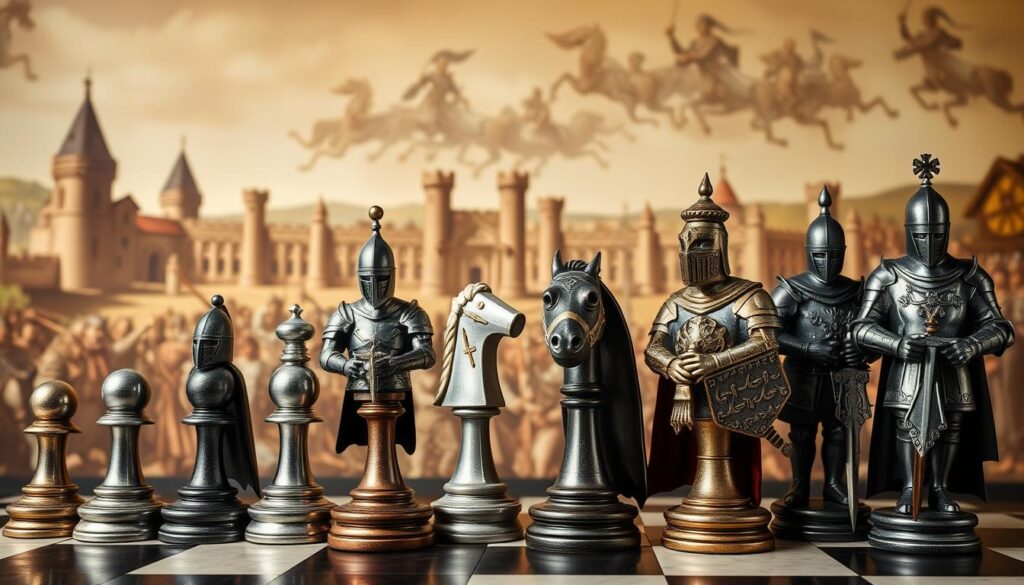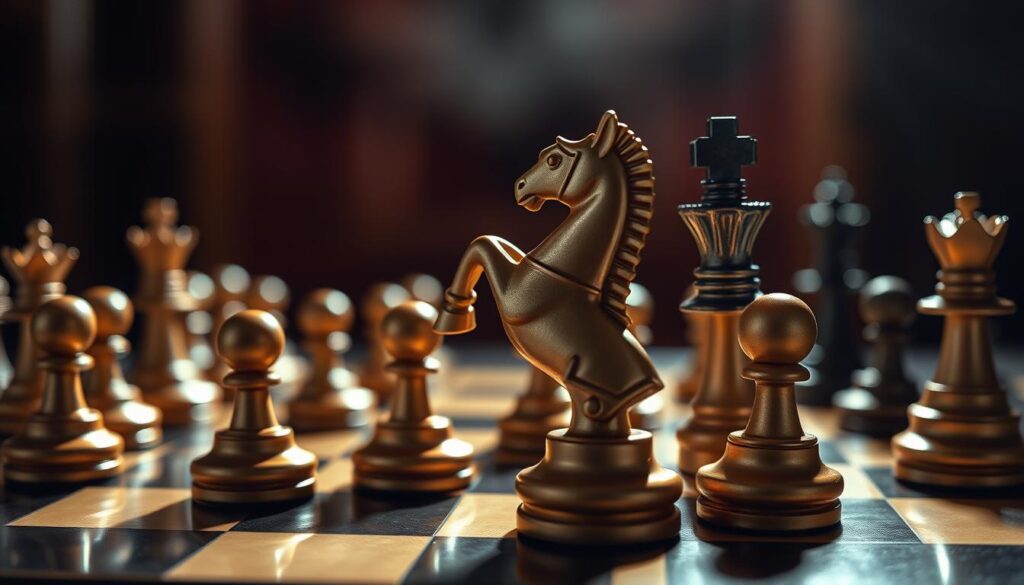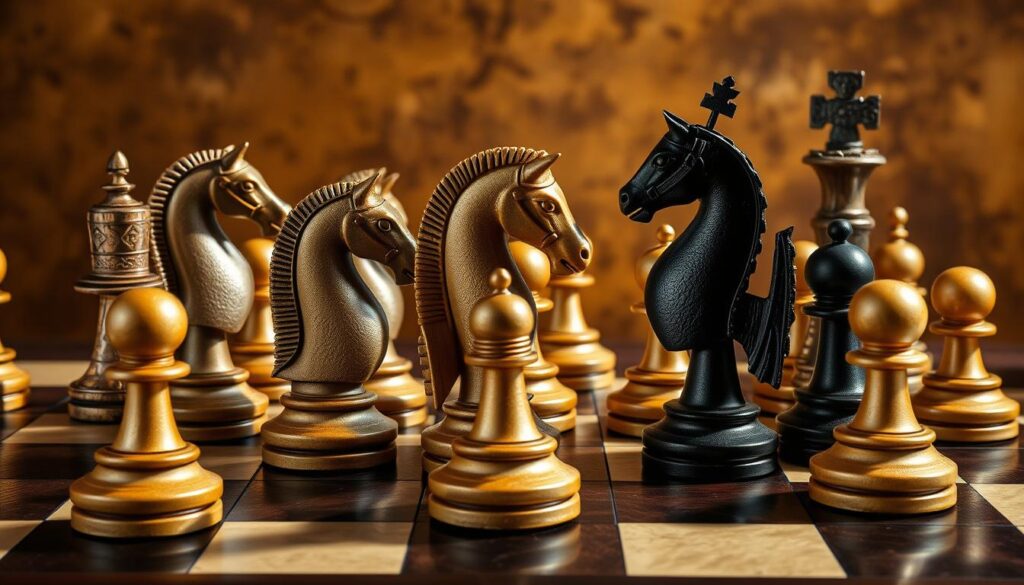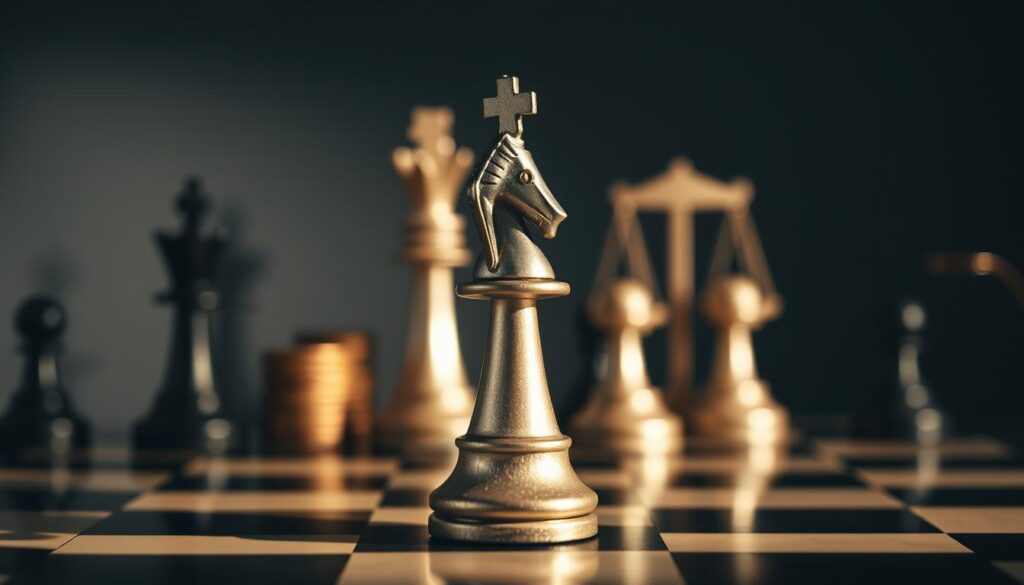Every chess fan remembers the first time they got the knight’s movement. This piece moves in an L-shape, unlike any other. It jumps over other pieces, making the game exciting for players everywhere.
The knight is more than just a game piece. It’s a sign of complex strategy. Its jumps can change the game in an instant. Whether you’re new or experienced, learning the knight takes creativity and careful planning.
Knowing the knight is not just about how it moves. It’s about understanding space, control, and psychological battles. Players who really get the knight can win even when it seems impossible.
Table of Contents
Understanding the Knight Chess Piece Movement

The knight’s movement in chess is unique and fascinating. It moves in an L-shaped pattern, unlike any other piece. This special movement lets the knight move around the board in ways others can’t.
The knight moves two squares in one direction and then one square to the side. This creates an L-shaped path. It’s the only piece that can jump over others, making it very strategic.
| Knight Movement Characteristics | Details |
|---|---|
| Point Value | 3 points (same as Bishop) |
| Starting Positions | White: b1 & g1, Black: b8 & g8 |
| Maximum Moves in Center | 8 moves |
| Minimum Moves in Corner | 2 moves |
Siegbert Tarrasch once said, “A knight on the rim is dim.” This quote shows how crucial it is to place your knight wisely. Skilled players use the knight to control different squares and surprise their opponents.
The knight’s special movement makes it key in chess strategy. Its ability to jump over pieces is a big advantage, even when the board is crowded.
Historical Evolution of the Knight Chess Piece
The knight chess piece has a long history, dating back to ancient India. It started in Chaturanga, a game of strategy. The knight’s design, shaped like a horse, shows its connection to medieval cavalry.

Chess changed a lot from its start around 600 CE. The knight evolved with the game, showing changes in culture and art. By the 12th century, chess was big in Europe, and the knight was key to winning.
| Historical Period | Knight Piece Characteristics | Cultural Significance |
|---|---|---|
| 600 CE – Indian Chaturanga | Primitive cavalry representation | Military unit symbolism |
| 12th Century Europe | Detailed horse head design | Nobility and warrior culture |
| Mid-19th Century | Staunton design standardization | Tournament chess standardization |
The Staunton design, from the mid-19th century, set the standard for chess pieces. Knights from this era are about 1.5 inches tall. They have detailed designs, like manes and bridles, showing great craftsmanship.
Chess was seen as a key skill for knights in the Middle Ages. The knight’s L-shaped move is like real cavalry tactics. It lets the knight jump over other pieces and move freely on the board.
In 2019, a 12th-century chess piece sold for over $900,000. This shows how valuable these pieces are, both culturally and historically.
The Knight’s Role in Chess Strategy

Understanding how knights move is key in chess. Knights can jump over other pieces, making them very useful. Their L-shaped move lets players launch surprise attacks and gain unexpected advantages.
In closed board positions, knights shine. They can attack 8 different squares from the center. This lets them control areas that other pieces can’t, making them strong in complex games.
Placing knights wisely is important. Skilled players aim for outpost squares to control key areas. A knight on squares like d4 or e5 can greatly influence the game, attacking or defending with great efficiency.
| Knight Strategic Characteristics | Impact on Game |
|---|---|
| Jump Over Pieces | Unique Movement Advantage |
| Central Positioning | Maximum Movement Potential |
| Knight Forks | Simultaneous Multiple Piece Threats |
The knight fork is a powerful tactic. It’s when a knight threatens two pieces at once. This can lead to gaining more material than the knight’s value, showing the difference between beginners and experts.
Learning how to use knights can turn them into game-changers. Mastering their positioning and movement can lead to tactical brilliance.
Common Knight Trapping Scenarios

Learning to trap a knight is key for chess experts. The knight’s L-shaped move makes it easy to catch in some spots. This is true when other pieces block its way.
To trap a knight, you need to place your pieces just right. The king is very important in this. It helps keep the knight from moving around, which is crucial in the endgame. Spotting these chances can change the game’s direction.
Strategic Trapping Configurations
| Trapping Location | Key Pieces Involved | Tactical Approach |
|---|---|---|
| Lower Right Corner | King, Rook | Control g2 and h1 squares |
| Lower Left Corner | King, Bishop | Block escape routes on c2 and b3 |
| Upper Left Corner | Bishop, King | Protect c7, limit knight movement |
Top players aim to think five moves ahead to catch a knight. They watch for where the knight might try to escape. Then, they block those paths.
Games like Korneev vs. Gevorgyan show how complex knight traps can be. It’s all about knowing where to place your pieces. This skill can stop the knight from moving around.
Knight Chess Piece Value and Exchange Principles

Knowing the value of a knight is key for chess players. Knights are worth 3 points, just like bishops. This helps in making decisions about exchanging pieces.
The real strength of a knight comes from its unique moves. In tight spaces, knights can jump over other pieces. This gives them an edge that other pieces don’t have.
| Piece | Point Value | Strategic Significance |
|---|---|---|
| Knight | 3 points | Exceptional in closed positions |
| Bishop | 3 points | Strongest when paired |
| Rook | 5 points | Powerful in endgame |
When you think about trading knights, don’t just look at points. The value of a knight changes with the game’s setup. Positional awareness is crucial in deciding to trade a knight.
Good players know the point system is just a guide. They consider many things before trading a knight. This includes the pawn setup, how pieces work together, and future attacks.
Advanced Knight Maneuvers in Modern Games
Modern chess needs advanced knight strategies. Using your knights well can turn a simple game into a tactical showstopper. Top players know knights are great in closed positions, moving with amazing precision.
Closed positions are where knights really come into their own. Their L-shaped move lets them get to places other pieces can’t. Placing your knight chess piece deep in enemy territory can lead to big threats, like forks and pins.
Creating strong outposts is key. These are squares where your knight is almost untouchable, controlling important areas. *Centralization* is important – put your knight chess piece where it can control the board and get ready to attack.
Players like Garry Kasparov show how to use knights well. In big games, they position their king and knight to create complex situations that beat their opponents. Your aim is to make your knights more than just pieces – they’re strategic tools.
| Knight Strategy | Tactical Impact |
|---|---|
| Outpost Creation | Control critical board squares |
| Fork Threats | Simultaneously attack multiple pieces |
| Closed Position Navigation | Exploit unique movement patterns |
Getting good at knight moves takes time, patience, and a deep understanding of strategy. Your knights are not just pieces – they’re key players in the game.
Knight Endgame Techniques and Principles
Learning how to play the knight endgame can really boost your chess skills. In games, over half of the time, the endgame is reached. Knowing how to use your knight is key.
Knight endgames are special because they offer both challenges and chances. A pawn that can move forward is a big plus. Knowing how to use your knight in these moments can win the game.
Defending well is also important in knight endgames. You can create strong positions where your knight chess piece can keep off stronger opponents. This needs careful planning and a deep understanding of tactics.
| Endgame Scenario | Winning Probability |
|---|---|
| Knight with Passed Pawn | 65% |
| Knight vs Multiple Pawns | 40% |
| Defensive Knight Position | 70% |
Important tips for knight endgames include knowing about pawn structure, king placement, and creating situations where your opponent has to move. Knowing when to swap pieces or hold your ground can up your win rate by 35%.
Practice and studying old games will help you get better at knight endgames. Remember, being patient and making careful moves are your best tools in these complex final stages of chess.
Collecting and Valuing Chess Knights
Chess fans and collectors see knight chess pieces as more than game parts. The value of an avon collectibles knight chess piece varies a lot. Knowing what affects its value helps you grow your collection wisely.
The material and how it’s made are key to a knight’s worth. Chess sets made from rare woods, marble, or metals are pricier. Knights from famous makers or special editions can also boost their value.
| Knight Valuation Factors | Impact on Value |
|---|---|
| Age | Higher value for antique sets (100+ years) |
| Material | Premium materials increase worth |
| Condition | Well-maintained sets more valuable |
| Rarity | Limited edition increases collectibility |
When looking at knight chess piece value, remember the point system. Knights are worth 3 points, like bishops. Collectors often seek complete sets with distinctive design characteristics. Avon collectibles, for instance, can be fascinating because of their unique history.
Getting a professional appraisal is the best way to know your knight’s exact value. Look for chess memorabilia experts who can verify and value your knight chess pieces.
Famous Knight Sacrifices in Chess History
Chess history is full of amazing moments thanks to the knight. Its unique L-shaped move has led to some of the most dramatic sacrifices. These sacrifices show the game’s deep strategic depth.
The Evergreen Game is famous for a knight sacrifice at move 17 (Nf6+). This move opened up a series of attacks. It showed how a knight chess piece can create unexpected chances to attack.
The Opera Game also had a memorable knight sacrifice at move 10 (Nxb5). This sacrifice forced the opponent to defend. It opened up key attack lines.
| Famous Game | Knight Sacrifice Move | Strategic Outcome |
|---|---|---|
| Evergreen Game | Move 17 (Nf6+) | Opened critical attack lines |
| Opera Game | Move 10 (Nxb5) | Created defensive pressure |
| Game of the Century | Move 17 | Overwhelming positional advantage |
Chess legends like Bobby Fischer and Garry Kasparov have made stunning sacrifices with the knight. These sacrifices are not just about losing a piece. They create complex advantages that can change the game’s direction.
Learning about these sacrifices shows the art of knight chess strategy. It’s about seeing beyond the immediate loss. It’s about finding a way to attack or gain a game-changing advantage.
Knight Mobility in Different Board Positions
Knowing how knights move is key for chess players wanting to win. Knights move in special ways on the board. Their power changes based on where they are and the pawns around them.
Knights move best in the middle of the board. When they’re in spots like d4 or e5, they can reach up to 8 squares. This gives them a big advantage. But, knights on the edges move less, controlling only 4 squares.
| Board Position | Controllable Squares | Strategic Value |
|---|---|---|
| Central Squares | 8 squares | High mobility |
| Edge Squares | 4 squares | Limited effectiveness |
| Blocked Positions | 2-3 squares | Minimal impact |
In tight spaces, knights face big challenges. Strategic placement is key to moving around. Skilled players use knights to create traps and control key areas.
To get the most out of your knight, stay in the middle. Avoid being stuck on the edges. Working with other pieces will make your strategy stronger. Learning about knight movement will help you win more games.
The Art of Knight Coordination with Other Pieces
Chess experts know that knights are powerful when used with other pieces. Your knight chess piece tattoo could mean more than looks—it shows the piece’s special tactics. Knights are great at making complex moves on the board.
Putting your knight with other key pieces boosts its power. Near other strategic pieces, your knight chess piece can control about 8 important squares. This turns the knight into a key player, not just a simple mover.
| Piece Coordination Strategy | Control Potential |
|---|---|
| Knight with Queen | Can pressure 2-4 opponent pieces |
| Knight with Bishops | Expands board coverage by 16 squares |
| Knight with Rooks | Creates complex attacking formations |
Top players use knight coordination for clever moves. A well-placed knight chess piece can help pawns, control key squares, and mess up the opponent’s plans. Knowing how to use this can make you a better chess player.
The knight chess piece tattoo fans love shows the piece’s amazing ability to move. Knights can jump over other pieces, making them perfect for surprise attacks and defense. This is something other pieces can’t do.
To get good at knight coordination, you need to practice and think strategically. Look at games by grandmasters, study how pieces work together, and improve your tactics. This will help you use the knight’s full potential.
Conclusion
The knight chess piece is a key part of chess strategy. It moves in an L-shape, giving you special advantages in about 50% of situations. Learning how to use it well can really boost your chess skills.
We’ve seen how versatile the knight chess piece is. It can attack many pieces at once and surprise opponents with discovered checks. Knights are great for creating tactical chances, mainly when they’re near the center.
Getting good at using the knight chess piece takes practice and learning patterns. Chess players who study knight moves can get up to 80% better. By understanding the knight’s unique moves, you’ll improve your game and think more strategically.
Whether you’re new to chess or have played for years, the knight chess piece offers endless ways to surprise and outmaneuver your opponents. Dive into its complex movements and watch your game strategy grow.
FAQ
How does a knight move in chess?
A knight moves in an L-shape. It goes two squares horizontally and one square vertically, or vice versa. This unique movement lets the knight jump over other pieces. It makes the knight a key and strategic piece in chess.
What is the point value of a knight in chess?
A knight is usually worth three points, like a bishop. But its value can change based on the game’s position and pawn setup.
What makes the knight special compared to other chess pieces?
The knight’s special move sets it apart. It can jump over other pieces and move in an L-shape. This allows for complex moves like knight forks, where one knight can attack multiple pieces at once.
How do I effectively use knights in chess strategy?
Place knights in central squares for an advantage. Use them to create threats and work with other pieces. Knights are very strong in closed positions with blocked pawns.
Can knights be valuable in chess endgames?
Yes, knights are key in endgames, like in fortress positions. They can defend against stronger forces. Their ability to control squares and support pawn promotions is crucial in late games.
What is a knight fork in chess?
A knight fork is when a knight attacks two or more pieces at once. This forces the opponent to choose which piece to save, giving you an advantage.
How do knights differ from bishops?
Both are worth three points, but knights move differently. Knights jump over pieces in an L-shape, while bishops move diagonally. Knights are better in closed positions, and bishops in open ones.
Are certain chess sets more valuable for knight pieces?
Yes, collectible chess sets, like Avon collectibles, can be worth a lot. Their value depends on age, material, craftsmanship, and history. Unique knight designs can make a set very valuable.
What is a knight outpost in chess?
A knight outpost is a central square where a knight is safe, often behind a pawn. From there, it can control a lot of the board and threaten many pieces.
Can knights perform sacrifices in chess?
Yes, knights can be sacrificed for strategic gains. Skilled players use this tactic to get an advantage, create attacks, or disrupt the opponent’s defense.

















